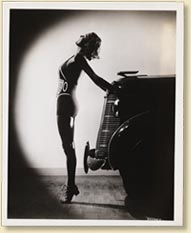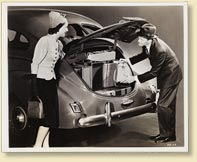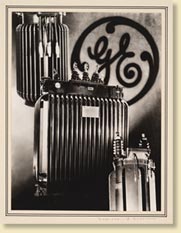The Product: Consumer Relations
The place of the photograph in advertising is unquestioned. It can accomplish things which no drawing or painting can possibly do.Annual of Advertising Art, 1924

 Faith in the economy was fueled by confidence in the ability of businesses to ensure both the creation and the consumption of mass-produced goods. The companies with which Ayres and Davenport corresponded often sent advertising images along with production photographs to convey a complete story from manufacture to sale of products. Independent ad agencies specialized in generating brand-name recognition for products through national advertising campaigns. Advertisements appearing in Ladies’ Home Journal, Saturday Evening Post, and Cosmopolitan exposed millions of readers to the latest cars, refrigerators, toothpaste, and breakfast cereals.
Faith in the economy was fueled by confidence in the ability of businesses to ensure both the creation and the consumption of mass-produced goods. The companies with which Ayres and Davenport corresponded often sent advertising images along with production photographs to convey a complete story from manufacture to sale of products. Independent ad agencies specialized in generating brand-name recognition for products through national advertising campaigns. Advertisements appearing in Ladies’ Home Journal, Saturday Evening Post, and Cosmopolitan exposed millions of readers to the latest cars, refrigerators, toothpaste, and breakfast cereals.
 In the industrial photograph collection, business school students could study techniques of commercial photographers who exploited the dual nature of the medium: photographic realism (or the illusion of it) within a highly theatrical context meant to evoke a strong emotional response to products and their benefits. Women populate automobile publicity shots in the role, for example, of “satisfied buyer” of a DeSoto with ample trunk space or of a “bathing suit model” for Pontiac. In a series of shimmering composite images, the studio of Underwood and Underwood employed the General Electric corporate monogram as a dramatic backdrop against which to celebrate the company’s products.
In the industrial photograph collection, business school students could study techniques of commercial photographers who exploited the dual nature of the medium: photographic realism (or the illusion of it) within a highly theatrical context meant to evoke a strong emotional response to products and their benefits. Women populate automobile publicity shots in the role, for example, of “satisfied buyer” of a DeSoto with ample trunk space or of a “bathing suit model” for Pontiac. In a series of shimmering composite images, the studio of Underwood and Underwood employed the General Electric corporate monogram as a dramatic backdrop against which to celebrate the company’s products.
- Baker Library | Historical Collections | Site Credits | Digital Accessibility
- Contact Email: histcollref@hbs.edu
